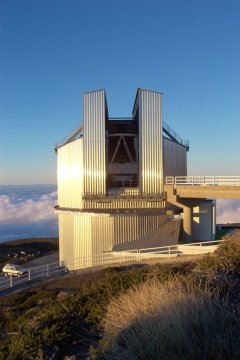General Info

The Fundación Galileo Galilei, Fundación Canaria (FGG), is a Spanish non-profit institution. The FGG's main aim is to promote astrophysical research by managing the Telescopio Nazionale Galileo (TNG), located at the Roque de Los Muchachos Observatory in the Canarian Island of San Miguel de La Palma, together with its scientific, technical and administrative facilities. The financial support is ensured by the Italian Istituto Nazionale di Astrofisica (INAF).
The 3.58m telescope TNG is the Italian facility located at the top of the Roque de Los Muchachos Observatory in the canarian island of La Palma. The optical design and manufacturing of the mirrors allow observations both at visual and infrared wavelenghts. For this reason the focal plane instrumentation is composed of detectors covering both spectral ranges. Remarkably, four instruments are permanently mounted at the two Nasmyth foci and can be easily interchanged during the night. Scheduling is also very flexible.
The focal plane instruments currently offered by TNG are:
- HARPS-N: a high-resolution (resolving power R=115,000), high-stability visible (383-693 nm) spectrograph. Currently the best instrument in the Northern hemisphere for the discovery and characterization of exoplanets, down to Earth-like size ones. Long-term stability allows an accuracy better than <1m/s in the radial velocity measurements.
- GIANO-B: a high-resolution (R=50,000) IR spectrograph, covering the 0.9-2.5 micron range, i.e., up to K band. Used for the characterization of exoplanet astmospheres and for the detailed abundance analysis of stellar atmospheres.
- DOLORES: a multi-mode imager/spectrometer at visual wavelengths with a field of view of 9’x9’ and spectral resolving power from R=300 to R=7,000. Well-suited for the monitoring of transient events and extragalactic sources.
- NICS: a multi-mode imager/spectrometer at infrared wavelengths (0.9-2.5 microns) with a field of view of 4.2’x4.2’ and spectral resolving power from R=40 to R=2,500. Well-suited for the monitoring of transient events and study of solar systems objects.
HARPS-N and GIANO-B are also available together in the GIARPS configuration, allowing the simultaneous acquisition of the spectrum of the same object with both spectrographs. In such a way, the 0.4-2.5 micron range is obtained in a single shot.
TNG handles observing time allotted by answering to four calls: INAF (Italian time and TNG-NOT agreement), CAT (Spanish time), ITP (International Time), and OPTICON.
TNG offers visitor and service observing modes. For the former a VA office will help and organise the travels and logistics. Service mode is scheduled according to user requests and is performed by TNG staff astronomers, in close communication with the PI.
Scientific data along with the necessary calibration files will be made available from the day after the end of an observing run via the Centro Italiano Archivi Astronomici (IA2) Archive. Note that data taken with HARPS-N and GIANO-B are reduced by the on-line pipelines and immediately available to the user for a real-time quality check and scientific use.
Example of papers describing TNG and its instruments:
Cosentino, R., et al.: Harps-N: the new planet hunter at TNG, Proceedings of the SPIE, Volume 8446, article id. 84461V, 20 pp. (2012)
Ghedina, A., et al.: Celebrating 20 years of scientific and technical results with the INAF-TNG Telescope, Proceedings of the SPIE, Volume 10704, id. 107041A 14 pp. (2018)
Harutyunyan, A., et al.: GIANO-B online data reduction software at the TNG, Proceedings of the SPIE, Volume 10706, id. 1070642 6 pp. (2018)
Poretti, E.: The TNG and its instruments after 20 years of operations, in Protoplanetary disks seen through the eyes of new-generation high-resolution instruments. Proceedings of the conference held 25-28 June, 2018 in Rome, Italy. Online at jedi2018, id. 28

